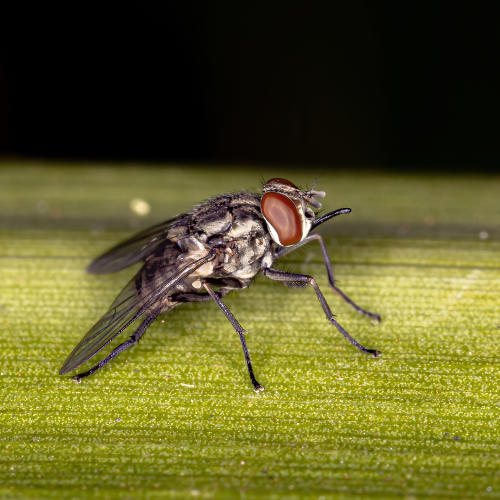Stable Fly

Proud Supporter of Disabled Veterans
No Contracts
Services provided without written contracts.
Introduction to
Stable flies (Stomoxys calcitrans) are common pests that affect both livestock and humans. Also known as biting house flies, these flies are notorious for their painful bites, which they use to feed on the blood of their hosts. Stable flies can cause significant distress to animals and humans alike, leading to reduced livestock productivity and disrupted outdoor activities. Understanding the biology, habits, and effective prevention methods for stable flies is crucial for managing infestations and maintaining a comfortable environment for both animals and people.
Recognition
Stable flies are medium-sized flies, measuring about 1/4 inch (6-8 mm) in length. They have a grayish body with four dark stripes on the thorax and a distinct checkerboard pattern on the abdomen. Unlike house flies, stable flies have piercing mouthparts, which they use to bite and feed on blood. Their mouthparts protrude forward, giving them a more aggressive appearance. Stable flies can be distinguished from other fly species by their painful bites and their habit of attacking both humans and animals during daylight hours.
Biology
Stable flies undergo complete metamorphosis, progressing through four life stages: egg, larva, pupa, and adult. Females lay their eggs in decaying organic matter, such as manure, wet straw, and other moist substrates. The eggs hatch into larvae (maggots) within a few days, and the larvae feed on the decaying material. After about two weeks, the larvae pupate, and adult flies emerge from the pupae in another week. The entire lifecycle from egg to adult can be completed in three to four weeks, depending on environmental conditions. Adult stable flies can live for several weeks, during which time they feed on blood multiple times a day.
Habits
Stable flies prefer warm, moist environments where organic matter is present. They are commonly found on farms, in stables, and around livestock facilities, but can also be found in urban areas near compost piles and decaying vegetation. Stable flies are aggressive daytime biters and feed on the blood of both animals and humans. They typically rest on walls, fences, and other surfaces when not feeding. Their bites can cause significant irritation, leading to decreased productivity in livestock and discomfort for humans. Stable flies are most active during the warmer months and can travel long distances in search of a blood meal.
Prevention
Preventing stable fly infestations involves maintaining good sanitation and reducing breeding sites. Regularly remove manure, wet straw, and other decaying organic matter from animal housing and surrounding areas. Ensure proper drainage to reduce moisture levels in and around stables and barns. Use fans and screens to keep flies out of animal housing. Apply insect repellents or fly control products to animals to reduce bites. Use traps and sticky tapes to capture adult flies. Maintain good hygiene and cleanliness in areas where stable flies are likely to breed and rest.
Professional
If stable flies become a persistent problem, professional pest control services can provide effective solutions. STL Pest Control offers comprehensive treatments to eliminate stable fly populations from farms, stables, and residential areas. Their technicians are trained to identify stable fly breeding sites and apply appropriate treatments, including insecticidal sprays, baits, and integrated pest management techniques. In severe cases, they may recommend ongoing maintenance plans to keep stable fly populations under control. Professional services ensure thorough and long-lasting control, providing peace of mind and a more comfortable environment for both animals and humans.



Our Office







